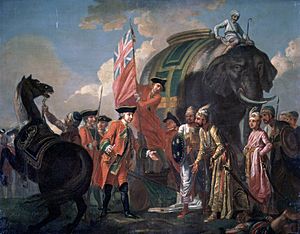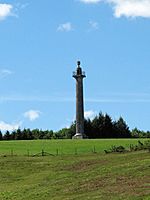Eyre Coote (East India Company officer) facts for kids
Quick facts for kids
Lieutenant-General Sir
Eyre Coote
|
|
|---|---|
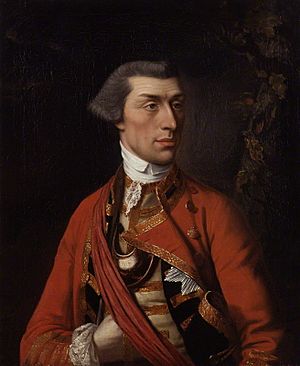 |
|
| Member of Parliament for Poole |
|
| In office 1774–1780 |
|
| Personal details | |
| Born | 1726 Kilmallock, Ireland |
| Died | 28 April 1783 (aged 56–57) Madras |
| Resting place | St Andrew's Church, Rockbourne |
| Awards | Order of the Bath |
| Nickname | Coote the Brave |
| Military service | |
| Allegiance | Great Britain East India Company |
| Branch/service | British Army Bengal Army |
| Years of service | 1745–1783 |
| Rank | Lieutenant general |
| Commands | 84th Regiment of Foot Commander-in-Chief of India |
| Battles/wars | Jacobite Rebellion Second Carnatic War Seven Years' War Second Anglo-Mysore War Battle of Plassey |
Lieutenant-General Sir Eyre Coote (1726 – 28 April 1783) was a brave British soldier and politician. He is most famous for his many years serving with the British Army in India. His big victory at the Battle of Wandiwash was a major turning point. It helped Britain gain control in India over France. His Indian soldiers, called sepoys, knew him as Coote Bahadur, which means "Coote the Brave".
Contents
Early Life and First Battles
Eyre Coote was born in Kilmallock, Ireland, in 1726. His father was the Reverend Chidley Coote. Eyre joined the army, the 27th Regiment of Foot, when he was young.
His first experience in battle was during the Jacobite rising of 1745 in Britain. Later, he became a captain in the 39th Regiment of Foot. This was the first regular British army regiment to serve in India.
Career in India: A Brave Commander
Coote's military career really took off in India. He played a key role in several important events.
Recapturing Calcutta
In 1756, part of Coote's regiment was sent to Madras. They joined Robert Clive to fight for Calcutta. The Nawab of Bengal's forces had recently captured Calcutta. The city was taken back easily in January 1757. Coote and Clive had some disagreements, but Coote proved himself a strong leader.
The Battle of Plassey
Coote quickly earned the rank of major. This was for his good actions in surprising the Nawab of Bengal's camp. Soon after, the famous Battle of Plassey happened. Coote's advice was very important for this battle to take place. After the Nawab's defeat, Coote led soldiers to chase the French for a long distance.
His excellent leadership earned him the rank of lieutenant-colonel. He also gained command of the 84th Regiment of Foot. However, his hard work in India made him very ill.
Victory at Wandiwash
In October 1759, Coote's regiment arrived to join the big fight between France and Britain in the Carnatic. He took command of the British forces at Madras. A French attack on Madras had just failed. On January 22, 1760, Coote led his troops to a major victory at the Battle of Wandiwash. This battle was very important for Britain's control in India.
Later, the remaining French forces were surrounded in Pondicherry. Coote supported the siege, which ended successfully on January 15, 1761. In the same year, he became a Member of Parliament in Ireland.
Soon after, Coote was given command of the British East India Company's forces in Bengal. He helped solve a serious problem between the Nawab Mir Qasim and another powerful leader.
Return to Britain and Parliament
In 1762, Coote went back to Britain. The East India Company gave him a special jeweled sword and other rewards. This was for his great service in India. In 1771, he was made a Knight of the Order of the Bath. This is a high honor.
In 1768, he was elected as a Member of Parliament (M.P.) for Leicester. Later, he moved to represent Poole in 1774. He stopped being an M.P. in 1780 when he returned to India.
Final Years in India
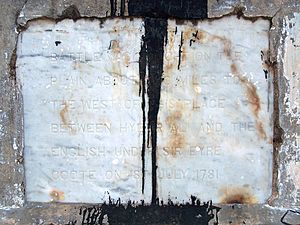
In 1779, Coote sailed back to India. He became the commander-in-chief of the company's forces there. He worked closely with Warren Hastings, who was the Governor-General of India. Hastings usually let Coote handle all military matters.
Second Anglo-Mysore War
When Hyder Ali started the Second Anglo-Mysore War in southern India, Coote returned to active fighting. On June 1, 1781, Coote won a major victory against Hyder at the Battle of Porto Novo. Coote's forces were greatly outnumbered, but they still won.
This was followed by another tough battle at Pollilur on August 27. The British won again. A month later, the Mysore troops were defeated at Sholinghur. Coote's last service was a very difficult campaign in 1782. This campaign further weakened his health.
Death and Legacy
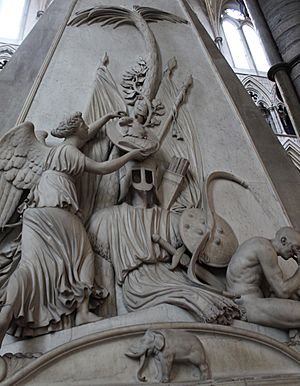
In 1782, Coote gave up his command and moved to Calcutta. But with more French attacks and problems between leaders, Hastings convinced Coote to return to his command. He sadly died from a stroke soon after returning to Madras on April 28, 1783. His body was brought back to England and buried in Rockbourne, Hampshire.
Coote is mostly remembered for his victory at Wandiwash and the capture of Pondicherry. These were key moments in the fight between Britain and France for control in India. Even though he sometimes argued with other British officers, his Indian soldiers loved him. After he died, a monument was built for him in Westminster Abbey. Another tall monument was built on his estate at West Park, Rockbourne.
He married a daughter of Charles Hutchinson in 1769. They did not have any children.


